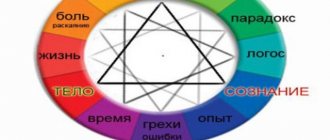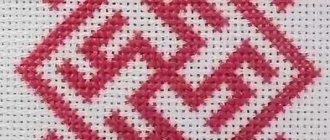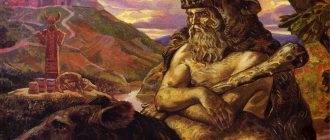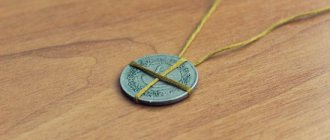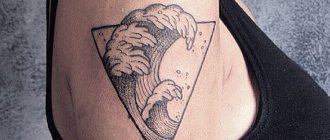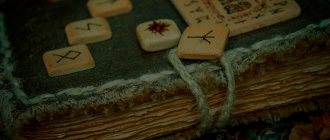What is luck
Luck is bestowed by the gods - this is what the ancient Romans believed, in whose pantheon there was Fortuna, the goddess of luck.
Success in business was explained not by the personal qualities and merits of a person, but by the favor of higher powers that needed to be appeased. This is how the first symbols bringing good luck appeared. They were implemented in amulets that needed to be worn on the body, household items placed in a certain way in the house, and even tattoos.
Until now, people treat luck as the highest good that needs to be attracted to themselves. Only then will business be successful and the house full.
How to attract good luck in ancient times
People have been interested in the concept of luck since ancient times. Our ancestors were very observant, so they paid attention to any changes that occur to a person under the influence of certain objects.
Ancient people did not have scientific knowledge, so categories such as love, protection, happiness and luck were attributed to amulets, amulets, plants and animals.
This is not inherent in individual civilizations, but in humanity as a whole: ancient Greece, Egypt, China, the Slavs - each nation had its own symbols of good luck and success.
Thus, the ancient Greeks had a goddess Tikha (the Romans had Fortuna), whose images were in many homes. The goddess holds a wheel in her hands (“the wheel of Fortune”), symbolizing the changeability of luck, its inconstancy.
Another attribute of Tikha (Fortune) is the cornucopia, which bestows upon everyone whom the goddess favors.
The ancient Egyptians had a symbol of good luck and success in business - the scarab beetle, which personified the god of invisible power, Khepri. To this day, Egyptians use amulets in the form of scarab beetles; they believe that they will be lucky in making their deepest dreams come true.
Symbols of success in China
The teaching of Feng Shui originated in China. The ancient Chinese noticed the dependence of their lives on certain objects, plants and their location at work or in their homes.
Symbols of good luck and wealth in Feng Shui are the dragon and the three-legged toad. The dragon, a strong national symbol, attracts good luck to the home, favors in business, sends happiness, protects the family - it all depends on the location of the figurine in the house. This Chinese symbol of good luck is believed to bring good luck if placed in the east or southeast. Wishes will certainly come true if there is a pearl in the dragon’s mouth. It is desirable that the symbol be green. Five-fingered - very strong, imperial, it is better to install it at work.
Another Chinese symbol of good luck is the three-legged toad. She became popular all over the world. The figurine represents a toad with a gold coin in its mouth, sitting on coins and a yin-yang symbol. It is believed that a three-legged toad will bring wealth and good luck if it stands in the southeast of an apartment or at the front door, giving the impression that it is jumping into the house. According to legend, this once treacherous animal was conquered by the Buddha and called upon to serve people by paying golden motets.
The symbol of happiness and good luck according to Feng Shui is a goldfish. The same Chinese character means the words “fish” and “abundance”, in addition, goldfish attracts marital happiness. The Chinese believe that an aquarium placed in an apartment where these beauties live in perfectly clean water and comfortable conditions will bring the owners good luck in business and family life. It is advisable to have nine of them: eight red or gold, and one black.
Laughing Buddha (Hotei) is a symbol of wealth, good luck and success in China and Japan. This is a very positive symbol, depicting an overweight Buddhist monk with a carefree smile. The Buddha holds a bag in his hands - there he has good luck, which everyone who asks receives free of charge. According to legend, the prototype of the laughing Buddha is a cheerful traveling monk who took away people's sorrows and problems, and in return gave them happiness and good fortune.
Another symbol of success in financial matters according to Feng Shui is the cup of wealth. It is made from ceramics, precious metals, copper or crystal. The bowl should not be empty, it must be filled to the brim with any objects, but three things must be there: soil or a twig from a rich person’s garden, banknotes with a face value of 988 (rubles, dollars, euros and other currencies), as well as a bunch of nine special Chinese coins with a square hole in the middle. The shape of the bowl should be special, similar to a pumpkin.
Hieroglyphs of health
Strong amulets “show” and “jen” are longevity and health. The best thing to do is to install them in the bedroom. In the first case, this will give a long life without disease, in the second - recovery, health, strength.
A tattoo with an oriental symbol requires serious attention. There are different ways to write Chinese characters, and their meaning can change dramatically from one curl or length of stick. Your hand will tremble, and instead of “1000 years of life” you can definitely get “rotten fish”.
Chinese characters of harmony are very popular among lovers of esotericism. But if Japanese culture is preferable, you should know that all Japanese characters visually duplicate Chinese ones. Because they were once borrowed from close neighbors. They are distinguished only by the auxiliary alphabet of simplified signs, which is not involved in Feng Shui.
Hieroglyphs that bring good luck
Closely related to the art of Feng Shui are hieroglyphic signs - symbols of good luck. Hieroglyphic writing is a reflection of the environment in the form of special graphic figures. The hieroglyphs that work best are those that a person wrote himself, according to certain rules. There are hieroglyphs - symbols of good luck in various areas: career, love, life affairs. The hieroglyph “Luck” will attract success and luck in all matters to your home. It is important that it is depicted in a confined space, which makes its effect stronger.
The hieroglyph “Wealth” will bring prosperity in financial matters and make business successful. To attract good luck, you need to place his image in the place where the process of raising funds is concentrated, maybe even in your wallet.
The symbol of wealth, good luck and success is the hieroglyph “Double Happiness”. Its powerful energy will give success in business (if it is located in the north), in family happiness (then the hieroglyph must be placed under the spouses’ bed), and if you place “Double Happiness” in your wallet, it will “invite” banknotes there.
Hieroglyphs can be depicted at home, on parchment, or on figurines. Another way to wear these signs is through tattoos, which also came from China. The symbols listed above are very popular among visitors to tattoo parlors. Often the hieroglyph accompanies images of a dragon or Laughing Buddha. There are also images of European symbols: a four-leaf clover and a horseshoe.
Chinese characters
For thousands of years, the Chinese have used traditional characters. In 1964, the Chinese government carried out a writing reform, simplifying the writing of Chinese characters. However, regardless of the style of writing, some signs remain ancient talismans. The principle is simple - the hieroglyph “love” is useful in affairs of love, and the hieroglyph “wealth” will help you get rich. It is also believed that favorable symbols qualitatively improve the circulation of qi energy in the house. And these signs themselves, and objects with their images, will not only be able to decorate your apartment, but will also attract love and happiness into your life. Finished products with hieroglyphs can be bought in specialized stores, but you can also draw such signs and symbols yourself.
Wealth
The hieroglyph “Wealth” helps to increase profits and is conducive to obtaining various material benefits. However, this talisman also helps to gain spiritual wealth. In Feng Shui, the sign of wealth is believed to create positive chi in a home or office.
Eternal love
This hieroglyph is usually used as a love talisman. He preserves the deep mutual feelings of people, which nothing can now destroy.
Business success
The hieroglyph of business success is good as a talisman or amulet for businessmen and creative individuals. It helps in the development of business relationships, the birth of new ideas and business success.
Money
The "Money" sign is the most popular hieroglyph in Feng Shui. The difference from the hieroglyph “Wealth” is that this symbol directly attracts monetary energy. For example, it will help you find additional sources of income.
Longevity
The Chinese character Shou ("longevity") is named after the Chinese god of longevity, Shousin. Images of this hieroglyph are often used by jewelry makers. A large number of rings, pendants, and pendants can be found on sale with this sign. Such products are given to elderly people with the wish of long life.
Health
And this hieroglyph itself and the objects on which it is depicted are usually given as gifts with wishes for a speedy recovery not only to the sick. The talisman helps to gain good health and maintain it for a long time.
Fulfillment of desires
Either the inscribed hieroglyph “Fulfillment of desires” itself, or a thing with such a sign is usually given to friends and acquaintances with wishes of all the best. They believe that it really helps to fulfill cherished desires and realize plans.
Love
The Chinese sign for “love” is one of the most beautiful among hieroglyph talismans. The pure beauty of the lines combined with the deep powerful meaning makes it one of the most popular in China. It can be seen in many Chinese paintings and works of art. This talisman not only strengthens marriage, but also smooths out quarrels and conflicts in the family. Thanks to this amulet you can find harmony, peace and a happy life with your loved one.
Wisdom
The hieroglyph “Wisdom” is placed anywhere in the room and its energy will add logic and informed decisions to you. As a talisman, the character “Wisdom” in China is especially popular among schoolchildren and students.
Prosperity
The hieroglyph "Prosperity" promotes growth and prosperity in all aspects of life. In Feng Shui it is believed that it can be placed in any sector that needs to be activated.
Happiness
This hieroglyph is a sign of good wishes. It helps awaken spiritual strength and internal energy. A person wearing this talisman will receive exactly what he envisions as happiness and well-being.
How the Slavs attracted good luck
The ancient Slavs were very observant and superstitious people: they noticed any little things related to their daily life. Trying to protect their home and attract the favor of higher powers, they made all kinds of amulets and talismans. These were not only symbols to be worn on the body, but also embroidery, dolls, even shutters on the windows. The bird of happiness is a well-known symbol of good luck among the Slavs. Made from certain wood (fir, spruce, pine or cedar), it was hung in the most honorable, “red” corner of the peasant hut. The bird of happiness was cut out of wood chips using a special technology, it was not glued together, the elements were held together with threads. The Slavs believed that the amulet would bring happiness to the house and accompany them in business.
Another Slavic symbol of good luck is the “Magic Diamond” amulet. Made in the shape of a plowed field, it not only brought good luck in working on the land, but also gave success in family affairs, good luck and prosperity.
The Slavic symbol that brings good luck to the house has reached the present day - the horseshoe. Our ancestors believed that finding a horseshoe on the road was a real gift of fate. It was hung above the door inside the home. To attract wealth and success, the horseshoe had to be placed with its horns up, so the desired benefits would not flow away. Why a horseshoe? Firstly, because the blacksmith who forged it was considered a warrior with a hostile other world. And secondly, the Slavs deified the nursing horse. Of course, in the modern world it is impossible to find a horseshoe on the road, so residents of Slavic countries use souvenir versions of it. A prerequisite is that you cannot buy this symbol. The horseshoe must be made of metal, precious or ordinary.
Chinese signs for money and luck
Chinese culture has always been rich in a variety of signs and superstitions associated with luck, prosperity and wealth. Some mysterious symbols come from word games, others from everyday experience. One way or another, Chinese life largely consists of established traditions, folk beliefs, and superstitions. In this regard, the desire of people from all parts of the world to touch this original store of knowledge in order to apply it to their modern life is easily explained. Everyone has a desire to understand how to act in a given situation, which is why the symbols of Chinese culture do not lose their relevance. In this article we will look at beliefs and signs designed to increase wealth, and also touch on things that hinder the achievement of well-being according to Chinese culture.
Lucky Colors in Chinese Culture
If you are at least a little familiar with Chinese culture, then it will not be a revelation to you that red is the national color, long symbolized with luck, success and prosperity. Starting from festive red envelopes with money that are received as gifts for the New Year and ending with the design of Chinese festivals. In addition to red, the color green is gaining popularity in culture, which is not only associated with ecology and life, but also with money. It’s not for nothing that many commercial establishments (banks, restaurants, etc.) like to paint them green.
When talking about wealth and its symbols, we cannot help but mention the color gold. The golden color directly corresponds to enrichment and at the same time to imperial nobility and greatness.
The color white, which denotes mourning, does not correspond to Chinese holidays and wealth. It was white that the ancient Chinese wore when they mourned the dead.
Numbers that symbolize business prosperity and wealth
Don't underestimate numerology, which is an important part of Chinese culture. Every businessman, and just an ordinary person, encounters a huge number of numbers every day. The superstition of modern Chinese goes so far that they tend to use telephone numbers that contain auspicious numbers, for example, 8, 18, 13 and 168. In Chinese, the word eight is consonant with the word luck. It is for this reason that 8 is associated with luck and prosperity. Often price tags in stores end with the number 8 - this helps sales.
Despite the difference in the pronunciation of numbers in different languages, we can definitely name the most successful of them:
• six symbolizes good luck in business (consonance with the Chinese word “flow”);
• eight means wealth and prosperity, and two eights mean its increase;
• nine carries the meaning of duration (symbol of the Chinese emperor), durability, which, for example, is suitable for concluding contracts, long-term partnerships, etc.
On the contrary, an unlucky number in Chinese culture is considered to be four, which has a similar sound to the word “death.” This figure is also avoided in many public places: in elevators, city addresses, telephone numbers, etc. Seven is consonant with the word “to deceive,” which is also very important to note. There are also combinations of numbers that the Chinese avoid, for example, 250, which means stupidity and irresponsibility.
Animals that bring wealth
Fish
Fish are an important symbol of unity and abundance. In Chinese, the pronunciation of the word "fish" is similar to another word that means "abundance", so fish are associated with abundance and wealth. The Chinese people have a tradition of cooking and leaving fish uneaten for the Spring Festival, as if leaving it for later and thereby demonstrating their excess in food. The Chinese and Japanese pay special attention to carp goldfish. Carps are one of the eight symbols of Buddha. Goldfish are associated with growth and increase in wealth, prosperity and wisdom.
Frog
Another animal whose image comes from ancient folklore is the frog. Many people are familiar with the figurine of a frog holding a coin in its mouth. This symbol refers us to a Chinese fairy tale, which tells about the rescue of a three-legged frog from a well, which brought coins from its chest for its salvation. The story of the frog symbolizes the growth of wealth and good fortune that arises from the manifestation of kindness and mutual assistance.
Deer
The name of the deer also did not escape word play and is very similar to the word “wealth”. The strong figure of a deer, a fast and sensitive animal, is associated with business life, filled with the desire for prosperity. For any working person who cares about his career, a deer figurine will be an excellent gift.
The Dragon
One of the defining symbols of Chinese culture is the dragon. There has long been a belief that the dragon is the Supreme Being, which is why the Chinese love to use it so much in architecture, dishes, decorations, etc. The dragon symbolizes luck, success, as well as strength and protection. Images of dragons are often placed in offices, where they stimulate the growth of prosperity and wealth. These images can be on vases, dishes, statues and other objects.
Horse
The oldest symbol of good luck, reward, happiness. Horses were used to transport goods and also as rewards for the winner of battles or competitions. It’s not difficult to guess why the horse is so often a symbol of career advancement, receiving a new position or bonus.
Elephant
Another symbol of monetary prosperity is the elephant. The Chinese teachings of Feng Shui characterize this animal as wise, majestic, and permeable. It is not without reason that the elephant symbolizes the ability to conduct business correctly and gain success in business, because this animal has long served people as a means of transporting expensive Indian goods, providing them with reliable protection with the help of its mass and strength.
We have listed the fundamental Chinese symbols associated with wealth, money and business. If you are doing business with the Chinese, then you need to understand the cultural aspects of your partner. At the right time, this can help to conclude a profitable deal or simply negotiate a good price.
Good luck talismans from the plant world
The simplest symbols of good luck are plants. Indeed, they do not need to be made - just purchase or pick them. Just pluck, because in this way a connection is established between a person and a plant. To ensure that luck accompanies the inhabitants of your home, you can plant indoor flowers at home that attract it. These include begonia, geranium and azalea. Moreover, the last two must certainly be adjacent to each other. Another plant that can provide good luck is the common ficus.
If we talk about garden plants, then the rose can be singled out as a symbol of love, good luck and prosperity. This is a peculiar version of the lotus flower, which gives good luck to the inhabitants of Asian nations.
A bay leaf will bring success in business to those who put it in their pocket. A laurel wreath is a symbol of winners; accordingly, this symbol will make the owner first in his affairs.
If we talk about plants that are symbols of good luck in the Chinese philosophy of Feng Shui, the first place is given to chrysanthemum and sakura.
Four-leaf clover
The most common symbol of good luck and luck - the four-leaf clover - deserves a separate discussion. This plant combines Christian culture and the legends of the ancient Celts. Clover with three leaves symbolizes the spiritual principle: Father, Son and Holy Spirit or Faith, Hope and Love. But the fourth leaf is success. Many people still believe in clover as a symbol of good luck in business. Even children, playing in the meadow, try to find this magical sign. Moreover, according to legend, luck will come only to those who find it completely by accident. For the sign to work, it must be dried and placed in a red bag. Finding a four-leaf clover is not that easy, the odds are 1:10,000.
The four-leaf clover is the symbol of Ireland. Saint Patrick, the patron saint of the country, used clover to convert pagan residents to Christianity, telling them the basics of faith, showing the unity of the Holy Trinity.
Login to the site
I will tell you about the most famous symbols of health and longevity in the Feng Shui tradition. Crane . The crane is a symbol of good luck. In popularity, this bird is second only to the mythical Phoenix. Ancient Chinese legends say that the crane has many magical properties. Among these properties are immortality and leadership over other birds. Cranes are distinguished by color: black, white, yellow and blue. Black cranes are the most powerful symbol of health and longevity. These birds are said to live up to six hundred years. Cranes are often depicted under a pine tree. And pine trees themselves are symbols of longevity. In ancient China, white cranes symbolized the position of a judicial official and were considered the patrons of bailiffs. There is also a belief that the cranes depicted on the lid of the coffin of the deceased quickly deliver his soul to heaven. Feng Shui masters strongly recommend having an image of a black crane in your home to symbolize the health and longevity of all family members. It is preferable to place figurines of cranes in the western sector of the house. If you have a garden, it is better to place the cranes in the western part of the garden. Pine .
This evergreen plant has been recognized in China as a symbol of longevity and health for several thousand years. There are pine trees that are thousands of years old. The Chinese strongly recommend planting at least one pine tree in your garden. Pines are also a symbol of eternal friendship, reliability and the presence of friends who will support you in any endeavor. Pine is also considered a reliable means of protection against wandering spirits that may wander into your home (brownies and goblins in the European tradition). Peaches . .
The peach is a symbol of immortality and is called a magic fruit. According to legend, the peach tree, which grows in the western paradise of Hsi Wan Mu, blooms once every three thousand years and bears the fruit of eternal life. The fruits of this tree are available only to the gods, but in Chinese mythology there were more than once mentions of immortal people and even animals who ate the fruits of immortality from the peach tree and were endowed with the ability to live forever. The wood of peach trees is considered a reliable amulet for protection against diseases and ailments. Peach also symbolizes marriage and brings happiness to the spouses. It is believed that parents can protect the family happiness of their daughters if they feed them peaches every spring. Deer. Deer live a very long time and have therefore been a recognized symbol of longevity since ancient times. The Chinese believe that deer is the only animal that can find immortality mushrooms. The Chinese god of immortality, Sau, is often depicted riding a deer and surrounded by evergreen pine trees.
Bamboo. This plant is another universally recognized symbol of health and longevity. Bamboo stems are widely used in Feng Shui practice for various kinds of crafts. Wind chimes and flets made from bamboo have the ability to dissipate the deadly energy of the Ball of Qi, which accumulates in rooms where there are sharp corners and ceiling beams.
Hanging anywhere in the house and activated with red thread, bamboo products perfectly cope with the negative effect of sharp edges and ceiling beams. It is also believed that bamboo furniture brings good luck in business and consolidates the successes already achieved in life. Bamboo furniture is recommended to be placed in the eastern and southeastern sectors of the house. Good luck to you, friends.
Read the source
Acorn
The oak was revered by many ancient peoples: the Druids held festivals in honor of it, the Scandinavians deified it, associating it with Thor, the son of Odin, the Romans identified the oak with the god Saturn, and the Slavs with the thunderer Perun. The fruit of the oak tree, a sacred tree, will give the owner good luck and happiness. It is enough to take it with you, and success will accompany you in everything. Women wore acorn beads to attract happiness in family life and childbirth. Acorns laid out on the windowsill will protect the house from misfortunes and evil forces, and good luck will settle there.
Animals and insects are symbols of luck
Symbols of good luck in the animal world play an important role. Since ancient times, humanity has tended to endow some animals and insects with magical properties.
The ladybug was revered by many cultures, they considered it a mediator between people and God. It is noteworthy that the name of the insect in all languages contains a reference to its divine origin: “Candle of God”, “God’s Maryushka”, “Chicken of God”. Even just meeting an insect was considered great luck; our ancestors believed that it brought them God's grace and success in business. Killing him was akin to a great sin.
In English, the name of the insect is lexically associated with the name of the Mother of God. It was believed that the ladybug was a messenger and assistant of the Virgin Mary.
In France and other European countries, medallions-amulets with ladybug are widespread. People believe that such a pendant is a symbol of good luck and luck, and the more black spots on the wings, the better. The maximum number is seven, such a ladybug will bring good luck and happiness. Charms with the image of a ladybug were hung on newborn children to protect them from evil.
From America, a symbol of good luck came to humanity - the rabbit's foot. Newborns were fanned with it so that the child would not be exposed to anything unkind, and adult owners of a rabbit's foot were always expected to succeed in business. Why were rabbits endowed with mystical properties? The ancient Celts noticed that these animals dig holes for themselves, and, accordingly, have a connection with the other world. In addition, the fact that rabbits are born with open eyes seemed sacred to ancient people. For a talisman, only the hind leg of a rabbit that was caught in a cemetery on a full moon is suitable. People still tend to trust the rabbit's foot for luck: many have this amulet.
The Land of the Rising Sun, Japan, also has symbols of good luck and success. The most common is Maneki-neko. It is a figurine of a cat with a collar around its neck and a raised paw. Sometimes Maneki-neko holds a coin in his paw. The Japanese greatly revere this talisman and consider it capable of bringing prosperity and good luck. Legend has it that the prototype Maneki-neko, the cat of a poor temple abbot, saved a rich merchant from death during a thunderstorm. He decided to thank the owner of his savior and donated funds for the restoration of the religious building. Since then, the cat and her owner have lived a full, comfortable life. Now Maneki-neko can be found in almost every home and office in Japan. If the cat’s left paw is raised up, the company will have an unprecedented flow of clients, and if the cat’s right paw is raised, good luck will accompany the owner of the talisman.
Other famous good luck talismans
In addition to the inhabitants of the animal and plant world, there are other symbols of good luck - material, inanimate objects. Endowing them with magical properties is associated with the metaphorical meaning they carry.
Thus, it is believed that a sailboat model can bring good luck and prosperity to its owner. This symbol was endowed with sacred meaning during the early days of navigation, when a ship arriving at the port carried wealth, rare and outlandish things. Being the owner of a ship was considered great luck. The sailboat moves with the help of the wind - a natural force beyond the control of man, only the gods. This is what attracts wealth and luck to a person. Currently, models of sailboats are in the offices of large and small companies, in homes, and shops. Initially, large models, quite fragile, brought from China, were used as symbols. Gradually, this rule moved aside, and now sailboats can be bought in souvenir shops, or even replaced with a painting. The sailboat should be positioned floating from the window or door to the owner, the god of wealth should be placed at the stern, and “treasures” should be placed on the deck: coins, jewelry, precious and semi-precious stones.
Another interesting symbol of happiness and good luck is the figurine of a chimney sweep. The custom came from Germany, where it was considered great luck to meet a chimney sweep - the darling of fate. After all, his work is very dangerous: at high altitudes he performs almost gymnastic feats while cleaning pipes. But the chimney sweep copes, it is obvious that luck is on his side. There is also a mystical meaning in the explanation of this symbol: the chimney sweep's broom is made of birch, a tree that carries fertility. For ancient people, the abundant gifts of the earth are happiness, blessing, and good luck. In addition, the chimney sweep gives people warmth - another sacred symbol. It turns out that his profession combined two of the most important symbols for a person: fertility and warmth.
Following Germany, the belief that a chimney sweep brings good luck spread throughout most European countries. Residents of Poland, Norway, Sweden, Austria and a number of other countries still give figurines of chimney sweeps in the hope that happiness and good luck will come to the person.
There are a lot of symbols that bring luck and happiness. Faith in the power and capabilities of a particular talisman will help you decide which symbol of good luck is right for a person. Only then will luck and success come to him.
What does the Chinese character for health mean?
Hieroglyph health
Everyone in the world knows that the Chinese language differs from other non-Oriental languages in that its writing uses hieroglyphs. But denoting different words is not the only function of these intricate and original signs. Each hieroglyph represents a specific sign, for example the hieroglyph health , luck, love, prosperity and many others.
The Chinese have always been famous for their traditions and customs. The use of hieroglyphs was no exception. They believe that the image of any hieroglyph carries its energy. For example, taking care of their physical health and the health of their loved ones, the Chinese use scrolls, postcards, medallions, figurines, etc., on which the Chinese character health is applied. Very often, images of various hieroglyphs are also applied to furniture, for example, on the doors of wardrobes, walls and even the ceiling.
If you are going to introduce some notes of Chinese culture into your life, then make sure that they are applied with skill and mean exactly what you would like. In our country, not everyone knows Chinese (but in vain!), so the image may turn out incorrect. In this regard, be very careful and, one might say, meticulous about the choice, writing and especially the meaning of hieroglyphs.
I would like to highlight a few, the images of which will not only enliven the interior of your home or decorate your accessories, but will also help improve your physical and moral condition.
— Hieroglyph health. This symbol not only helps to maintain the health and well-being of all family members, but also promotes a speedy recovery for those who are already sick. The hieroglyph health consists of two parts. The first part of this symbol means vigor, health and endurance, but the second part literally means “abundance and strength.” Very often, the Chinese, wanting to please and cheer up their elderly relatives and friends, give them various kinds of souvenirs and gifts with the hieroglyph health on them.
This symbol has been used for a long time; even in ancient times, scrolls with its images were found. It is believed that with its energy this sign prevents diseases and prolongs people’s lives. This is quite a possible fact, given the many examples of Chinese longevity and legends about healing Chinese medicine.
— The symbol of wealth helps increase income and attracts various material benefits. This symbol also increases the spiritual wealth of every person who has chosen this hieroglyph for themselves.
— The symbol of longevity, like the hieroglyph health, helps to extend life expectancy. Place an image of this symbol in your bedroom and you will not be afraid of any illnesses.
Home decoration
— The hieroglyph love, as is clear from the name, brings love into the home, harmony in family relationships, prevents disagreements between loving people, strengthening their marriage bonds.
— The symbol of dream fulfillment helps to realize all your plans and desires. This applies to both business dreams and personal aspirations.
— There is a universal hieroglyph, so to speak, that summarizes health, luck, prosperity and happiness, and it is called prosperity. It works relative to what you want. If you want spiritual wealth, then this symbol will help you find peace and tranquility.
Belief in the miraculous abilities of hieroglyphs has already spread throughout the world. Chinese symbols can be found in the home of a person of any nationality and religion. The appearance of some oriental symbol in a home, be it a hieroglyph for health, love, happiness or money, always internally pleases a person’s soul. You look at this image on a figurine or souvenir and are filled with miraculous energy.
Dmitry Ornatsky Views: 42792
